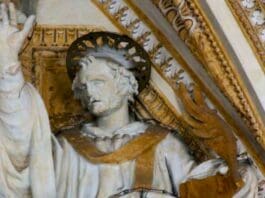
Pope Saint Hyginus, who held the position of the Bishop of Rome from approximately 138 to 140 AD, was originally from Athens, Greece. His birthdate remains unknown. As pope, he was instrumental in structuring the prerogatives of the clergy and establishing the levels within the ecclesiastical hierarchy. One of his notable decrees was the mandatory consecration of all churches.
Hyginus succeeded Pope Telesphorus, whose death is believed to have occurred around the beginning of Emperor Antoninus Pius’s reign, in either 138 or 139. However, the precise chronology of these early Roman bishops remains unclear due to the limited reliability of existing historical sources.
The Liber Pontificalis identifies Hyginus as Greek, and there is a speculative suggestion that he was a philosopher before his papacy, likely due to the similarity of his name with two Latin authors. During his papacy, notable figures such as the Gnostic Valentine and Cerdo were active in Rome. Valentine remained in Rome until the pontificate of Anicetus, while Cerdo initially rejoined the Church after renouncing his views but later reverted to his heretical beliefs and was expelled.
The Liber Pontificalis credits Hyginus with organizing the Church’s hierarchy and establishing ecclesiastical precedence. However, this claim, also made in reference to Pope Hormisdas, is generally regarded as historically unreliable. Eusebius, a renowned historian, notes that Hyginus’s pontificate lasted four years. There are no records suggesting that Hyginus died as a martyr. After his death, he was buried on Vatican Hill near Saint Peter’s tomb. His feast day is commemorated on January 11.
Photo credit: Public Domain via Wikimedia Commons
The post Pope Saint Hyginus appeared first on uCatholic.
Daily Reading
Wednesday of the First Week in Ordinary Time
Reading I Hebrews 2:14-18 Since the children share in blood and Flesh, Jesus likewise shared in them, that through death he might destroy the one who has the power of…
Daily Meditation
Ripples in a Pond
Click here for daily readings There is something captivating about tossing stones into a pond or lake. Maybe it is the disappearance of the stone as it plops into the…




